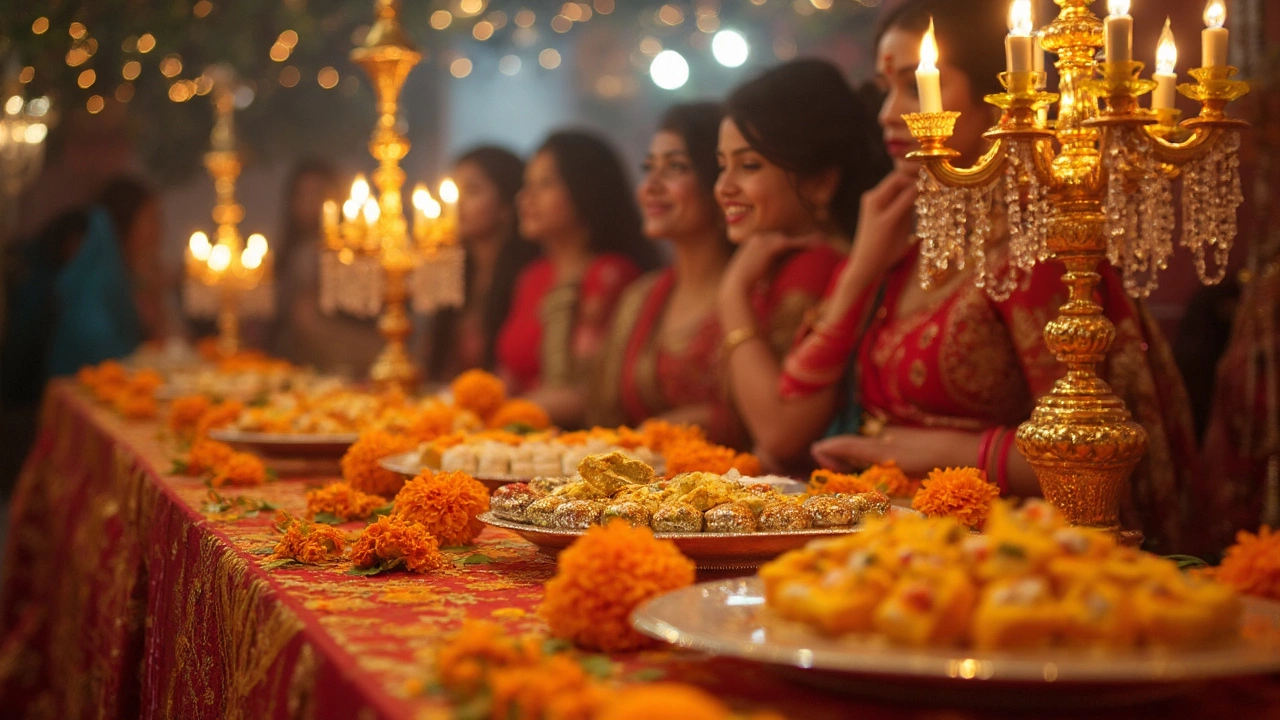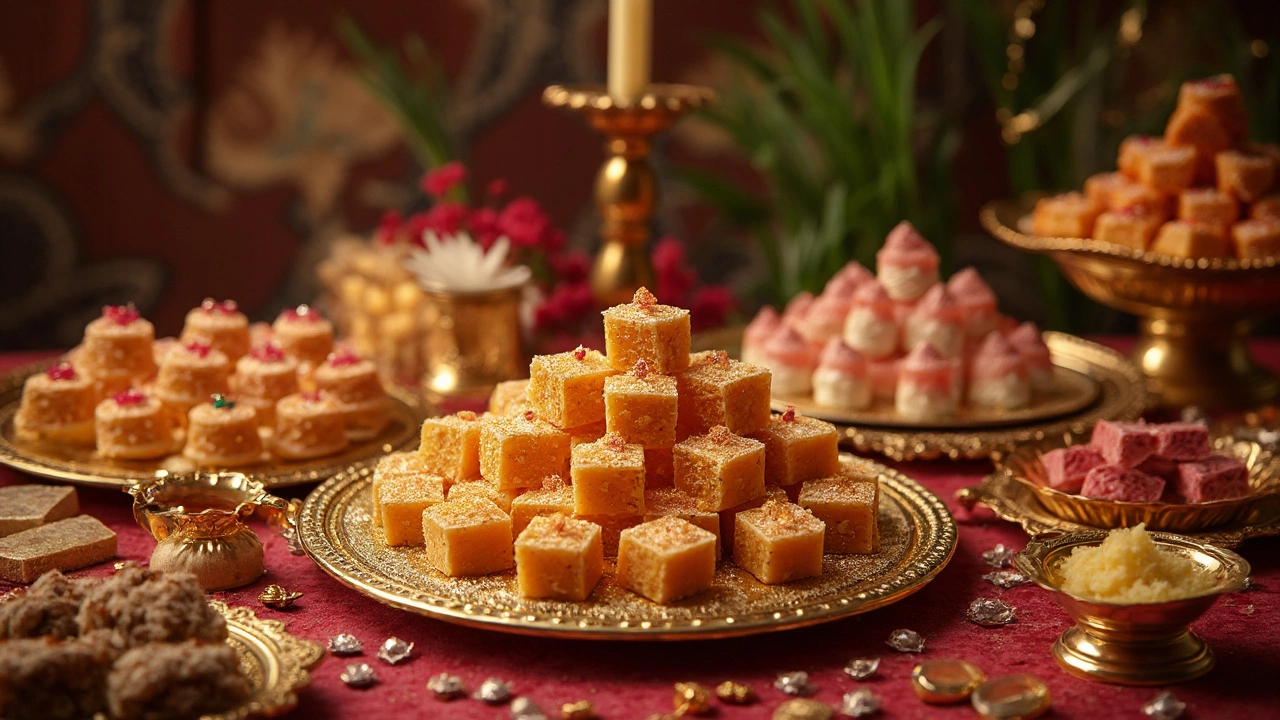Ever felt like indulging in something so sweet yet so exclusive that it turns heads? Let me introduce you to a fascinating detail from the world of Indian sweets. Khoya Mithai, with its hefty price tag, is renowned for being the most expensive sweet in India. But what makes it so special, you ask?
First off, it’s the ingredients. Not just any sugar and milk will do here. We're talking about saffron, Bengal gram flour, and pure ghee, often sourced specially to keep the quality at its peak. The richness of khoya, a milk solid, forms the heart of this sweet delight. It’s not just about taste; it’s a culinary art form that calls for both precision and passion.
Preparation is nothing short of a labor of love. Imagine hours of stirring, folding, and waiting – yes, lots of waiting! The process can take more than a day, as craftsmen meticulously transform these raw ingredients into luxurious pieces of art.
- The Luxurious Sweet: Khoya Mithai
- Unique Ingredients and Preparation
- Taste and Tradition
- Where to Find It
- Tips for Enjoying Indian Sweets
The Luxurious Sweet: Khoya Mithai
Khoya Mithai isn't just any Indian sweet. It stands out not just for its delightful taste, but also for the opulent status it holds. Let's dive into why this treat is tagged among the most expensive Indian sweet.
Rich Ingredients
What truly makes Khoya Mithai luxurious is its ingredients. The key ingredient, khoya, is essentially milk that's been meticulously cooked down to a solid, lending the sweet its signature creamy richness. Add to this the finest saffron strands, cardamom, and high-quality nuts like almonds and pistachios, and you have a luxurious concoction.
Time-Intensive Preparation
This sweet is a masterpiece of patience and precision. To achieve the perfect texture and taste, khoya is stirred over low heat for hours. Then, it’s gently flavored and shaped into intricate designs that make it almost too beautiful to eat. A lot of the value comes from the skill and time invested by sweet makers, ensuring consistency in flavor and shape.
How Much Does It Cost?
Mithai like this doesn't come cheap. Depending on the region and the quality of ingredients, the price can soar well beyond what you’d spend on your usual treat. This indulgence is often reserved for special occasions, where its presence signifies prosperity and festivity.
| Ingredient | Description | Purpose |
|---|---|---|
| Khoya | Condensed milk solid | Main ingredient providing richness |
| Saffron | Delicate and rare spice | Enhances flavor and adds color |
| Cardamom | Spice with a complex aroma | Adds depth to the taste |
| Almonds & Pistachios | Nuts | Offers texture and crunchy contrast |
Indulging in Khoya Mithai is like savoring a piece of Indian culture and tradition. It's a sweet reminder of the skillful artisans and the culinary heritage that makes it so special. Next time you're at an Indian sweets shop, take a moment to appreciate the care behind these sweet delights.
Unique Ingredients and Preparation
There's something particularly captivating about the mysterious allure of Khoya Mithai. It’s not just another piece of Indian sweets—it's a masterpiece of flavors, brought together through rare ingredients and complex preparation.
Unveiling the Ingredients
The soul of a Khoya Mithai is its rich base of khoya, also known as mawa. What makes this khoya remarkable is its slow-cooked preparation that involves boiling milk until it thickens to a creamy consistency.
Then there's saffron, known as the 'golden spice'. A few delicate strands of this spice can add an exotic aroma and a luxurious hue to the sweet. Almonds and pistachios, slivered and often roasted, lend a crunchy texture.
Pure ghee is non-negotiable. It is not just a cooking fat but a flavor enhancer, binding all ingredients beautifully. And don't forget Bengal gram flour – often the silent hero – adding an earthy base to the sweetness.
The Art of Preparation
- Preparing Khoya: It's a day-long affair, continuously stirring milk until it forms the perfect base.
- Infusing Saffron: It demands patience. Infuse the strands in warm milk to release their full potential.
- Mixing and Shaping: All ingredients are expertly combined, then shaped into intricate designs, adding an artistic touch.
If you ever end up in a quaint sweet shop in India, take a moment to appreciate the craftsmanship behind each piece of this expensive Indian sweet. A glance at this sweet marvel might just give you a sneak peek into a rich tradition of culinary skills passed down through generations.

Taste and Tradition
When it comes to Khoya Mithai, the taste is what elevates it from a simple dessert to a lavish experience. The richness of the khoya, combined with seasonal flavors like cardamom and saffron, creates a delectable melt-in-your-mouth experience. The sweet is often topped with an edible silver foil called 'vark,' which adds a touch of elegance and a gentle crunch.
Traditionally, these Indian sweets are crafted during celebrations and festivals, making them a symbol of joy and prosperity. This isn't just any dessert; it carries the essence of Indian culture, where food is central to festivities. Each bite takes you on a trip down memory lane, reminding you of family gatherings, colorful markets, and joyous occasions.
Khoya Mithai has its roots deeply embedded in the culinary history of India. Originating from the northern parts of the country, it was initially prepared by local halwais (sweet makers) for royal families. The process hasn't changed much over the centuries, keeping its authentic form intact.
Evolution Over Time
With modernization, the variety of this expensive Indian sweet has expanded. Some versions now incorporate ingredients like pistachios and almonds, making them even more luxurious. Yet, the traditional taste remains unparalleled, often getting preference over modern tweaks.
These sweets aren't just about indulgence but are also often associated with gifting, especially during festivals like Diwali and weddings. Receiving nicely packed Khoya Mithais as gifts is seen as a gesture of respect and goodwill.
When you savor this delight, you’re not just tasting a dessert; you’re partaking in centuries of culinary tradition. Each piece tells a story of craftsmanship, devotion, and culture that has stood the test of time.
Where to Find It
If you're dreaming of tasting this extravagant Indian sweet, you’re in for quite the adventure! From the bustling markets of Delhi to the elegant sweet shops of Mumbai, Khoya Mithai graces the shelves of only the most distinguished places.
Top Spots Around India
- Haldiram's, New Delhi: Known for its exceptional quality and variety of mithai, Haldiram's in New Delhi is often the go-to place for those seeking the luxury of Khoya Mithai. It's one of those places where tradition meets taste.
- Sweet Bengal, Mumbai: For those on the western coast, Sweet Bengal is a must-visit. Known for incorporating both traditional and modern techniques, this shop is famous for its fine sweets, including the pricey Khoya Mithai.
- K.C. Das, Kolkata: If you’re in the east, K.C. Das is a classic choice. Famous for its rich history and even richer desserts, it’s a beloved spot for locals and tourists alike, offering a taste of this sumptuous sweet.
Luxury Dessert Markets
Besides the iconic stores, luxury sweet markets in cities like Hyderabad and Chennai are making waves. These markets not only feature the high-end Mithai but also provide a unique shopping experience. Some even offer live demonstrations of how these sweets are made!
If you happen to visit during a festival, keep your eyes peeled for seasonal pop-up shops. They often showcase special editions of Khoya Mithai, adding an extra layer of exclusivity to the treat.
Quick Tips
- Call ahead to ensure availability, as this expensive Indian sweet can sell out quickly.
- Check for online options; many premium stores now deliver across the country.
- Don’t hesitate to ask for recommendations. Locals often know the best and most authentic places.
Dive into this delightful quest, and you'll discover that finding Khoya Mithai is as much a part of the experience as tasting it. Happy hunting!

Tips for Enjoying Indian Sweets
Trying out Indian sweets can be a real treat, but knowing a few tips can make the experience even better. Let's dive into how you can maximize your enjoyment and appreciation of these delightful treats.
Know Your Sweets
With such a huge variety, it's good to know the basics. Whether it's the sugary goodness of jalebi or the rich flavor of khoya mithai, recognizing these will enhance your tasting experience. Each sweet has its unique taste and texture, making it worth the try.
Pairing with Drinks
Pairing sweets with the right drink can elevate your experience. A cup of strong chai or even a glass of milk can cut the sweetness and balance flavors, especially when dealing with richer sweets like Mithai.
Storage and Freshness
Always ask the vendor about the shelf life. Freshness matters as most Indian sweets contain milk. Ideally, enjoy them right after purchase, or if storing, make sure to refrigerate and consume within the recommended time.
Sharing is Caring
Indian sweets are all about sharing joy. Bring them along to gatherings or share them with friends. It’s a great way to enjoy more varieties without overindulging.
Where to Buy Authentic Sweets
Buying from reputable vendors ensures authenticity. Look for shops known for their sweets, especially if looking for something as luxurious as expensive Mithai. A bit of research goes a long way!
| Sweet Type | Best Pairing Drink | Recommended Shelf Life |
|---|---|---|
| Jalebi | Chai | 2 days |
| Khoya Mithai | Milk | 3 days |
| Barfi | Black Coffee | 1 week |
